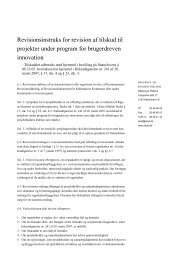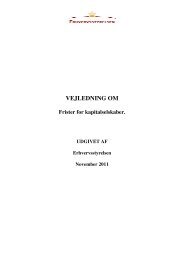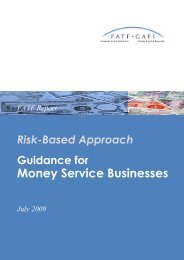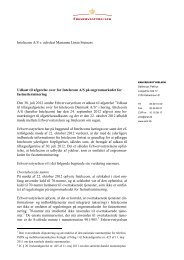Competing in the Single Market - SMEs and ... - Erhvervsstyrelsen
Competing in the Single Market - SMEs and ... - Erhvervsstyrelsen
Competing in the Single Market - SMEs and ... - Erhvervsstyrelsen
Create successful ePaper yourself
Turn your PDF publications into a flip-book with our unique Google optimized e-Paper software.
INTRODUCTIONAfter more than 10 years of massive reforms <strong>and</strong> transformation, many of <strong>the</strong> so-called ‘transitioneconomies’ <strong>in</strong> Central <strong>and</strong> Eastern Europe are <strong>in</strong> <strong>the</strong> process of complet<strong>in</strong>g <strong>the</strong> transformation to afully-function<strong>in</strong>g market economy, <strong>and</strong> <strong>in</strong> particular, of prepar<strong>in</strong>g <strong>the</strong>ir economies for accession to<strong>the</strong> European Union. One of <strong>the</strong> central questions raised <strong>in</strong> this context is how well <strong>the</strong>ir companieswill adjust to <strong>the</strong> consequences of jo<strong>in</strong><strong>in</strong>g <strong>the</strong> European S<strong>in</strong>gle <strong>Market</strong>. There are, <strong>in</strong> fact, widespreadconcerns that <strong>the</strong> Small <strong>and</strong> Medium-sized Enterprises (<strong>SMEs</strong>) will not be able to capture <strong>the</strong>opportunities nor cope with <strong>the</strong> new challenges aris<strong>in</strong>g with <strong>the</strong>ir <strong>in</strong>tegration <strong>in</strong>to <strong>the</strong> EuropeanUnion.A dynamic <strong>and</strong> competitive SME sector is pivotal for future economic growth <strong>and</strong> employment <strong>in</strong>most countries. The presence of structural weaknesses or obstacles prevent<strong>in</strong>g <strong>SMEs</strong> from compet<strong>in</strong>geffectively <strong>in</strong> <strong>the</strong> S<strong>in</strong>gle <strong>Market</strong> would significantly <strong>in</strong>crease <strong>the</strong> transition costs <strong>and</strong> result <strong>in</strong> a slowerpace of economic development <strong>in</strong> <strong>the</strong> EU Accession Countries than might o<strong>the</strong>rwise be possible. 1These issues are greatly relevant for o<strong>the</strong>r transition economies as well.The ability <strong>and</strong> capacity of <strong>in</strong>dividuals, companies, <strong>and</strong> <strong>in</strong>stitutions to <strong>in</strong>novate will play a vitalrole <strong>in</strong> ensur<strong>in</strong>g <strong>the</strong> competitiveness <strong>and</strong> well-be<strong>in</strong>g of EU Accession Countries dur<strong>in</strong>g <strong>the</strong>ir nextdevelopment phase. By streng<strong>the</strong>n<strong>in</strong>g <strong>the</strong>ir <strong>in</strong>novation systems, <strong>the</strong>se countries can significantlyimprove <strong>the</strong> ability of <strong>SMEs</strong> to compete <strong>in</strong>ternationally, thus mak<strong>in</strong>g a vital contribution to ensur<strong>in</strong>ga successful transition of <strong>the</strong>ir economies to <strong>the</strong> S<strong>in</strong>gle <strong>Market</strong>.The aim of this report is to exam<strong>in</strong>e key challenges for <strong>SMEs</strong>, national <strong>in</strong>novation systems <strong>and</strong>policymakers <strong>in</strong> four of <strong>the</strong> EU Accession Countries – namely Estonia, Latvia, Lithuania <strong>and</strong> Pol<strong>and</strong>,henceforth referred to as <strong>the</strong> B4 countries – <strong>in</strong> <strong>the</strong> context of <strong>the</strong>se countries’ accession to <strong>the</strong> S<strong>in</strong>gle<strong>Market</strong>. In particular, <strong>the</strong> report identifies some of <strong>the</strong> hurdles which companies, <strong>and</strong> particularly<strong>SMEs</strong>, <strong>in</strong> <strong>the</strong> B4 countries have to overcome if <strong>the</strong>y are to be able to thrive <strong>and</strong> prosper with<strong>in</strong> <strong>the</strong>European Union. Fur<strong>the</strong>rmore, we exam<strong>in</strong>e how governments can support or put <strong>in</strong> place appropriatemechanisms enabl<strong>in</strong>g <strong>the</strong> development of a critical mass of <strong>in</strong>novative <strong>SMEs</strong> that will be able tocompete successfully <strong>in</strong> <strong>the</strong> S<strong>in</strong>gle <strong>Market</strong>, <strong>and</strong> thus catalyse <strong>in</strong>novation <strong>and</strong> competitiveness for <strong>the</strong>ireconomies as a whole. Adopt<strong>in</strong>g a comparative perspective, <strong>the</strong> report exam<strong>in</strong>es <strong>the</strong> structure of,policies for, <strong>and</strong> challenges fac<strong>in</strong>g <strong>SMEs</strong> <strong>in</strong> Estonia, Latvia, Lithuania <strong>and</strong> Pol<strong>and</strong>, <strong>and</strong> also presentssome policy recommendations.A comparative analysis of <strong>the</strong>se countries is useful for several reasons. In addition to <strong>the</strong>ir closegeographic proximity <strong>and</strong> location on <strong>the</strong> Baltic Sea, <strong>the</strong> B4 countries share a number of important<strong>and</strong> <strong>in</strong>terest<strong>in</strong>g parallels <strong>and</strong> commonalities related to <strong>the</strong>ir history, culture, <strong>in</strong>stitutional structures,political <strong>and</strong> economic developments <strong>and</strong> challenges, among o<strong>the</strong>rs. In terms of policy orientation,<strong>the</strong> B4 are presently striv<strong>in</strong>g to build <strong>the</strong> framework conditions <strong>and</strong> implement policies that areneeded for streng<strong>the</strong>n<strong>in</strong>g <strong>the</strong>ir structural reforms <strong>and</strong> national competitiveness.While <strong>the</strong>se four countries have a lot <strong>in</strong> common, <strong>the</strong>re are also significant differences between<strong>the</strong>m, relat<strong>in</strong>g not only to <strong>the</strong> obvious diversity <strong>in</strong> size, but also to important aspects of <strong>the</strong>ir social<strong>and</strong> economic assets, policy orientation <strong>and</strong> organisation. The above-mentioned comb<strong>in</strong>ation ofsimilarities <strong>and</strong> differences provides a useful basis for ga<strong>in</strong><strong>in</strong>g valuable <strong>in</strong>sights <strong>and</strong> lessons from a1The EU Accession Countries jo<strong>in</strong><strong>in</strong>g <strong>the</strong> European Union on May 1, 2004 are Cyprus, Czech Republic, Estonia, Hungary, Latvia, Lithuania, Malta, Pol<strong>and</strong>,Slovak Republic <strong>and</strong> Slovenia. Bulgaria <strong>and</strong> Romania hope to jo<strong>in</strong> by 2007, while Turkey is not currently negotiat<strong>in</strong>g its membership.13
















